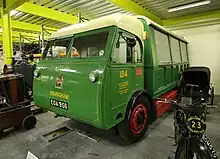
The Electricar DV4 is a 4-ton electric dustcart used by the city of Birmingham, England, between 1938 and 1971.[1] The DV4 was developed as the result of a collaboration between the Birmingham salvage department and Electricars based on the salvage department's experience with its previous electric vehicles.[2] They were replaced by diesel-powered designs with one surviving in the collection of Birmingham museums.
History
The Electricar DV4 was a two-axle design weighing 4 long tons 2 cwt 1 qr (9,210 lb or 4.18 t) when empty.[3] It ran off 80 volts provided by 40 cells.[2] Rubbish would be loaded in from the side and would be emptied by tipping the body using a hydraulic ram.[2] It had the capacity to hold up to 12 cubic yards (9.2 m3) of refuse.[2] The electricity used to charge the DV4 (and the city's other electric dustcarts) was provided by the incinerators it took the waste to.[4]
Seventy-two DV4s were ordered and the first was delivered to the salvage department on 1 May 1938.[2] Thirty-four had been delivered by the start of the Second World War.[2] Production continued but was disrupted by the war and halted entirely in 1942.[5] Production resumed in 1943 and the order was completed in 1944 with the last DV4 entering service on 1 April 1944.[5][6] During the war, a DV4 based at the Montague Street Destructor was hit by a small bomb which damaged its chassis.[7] The DV4 in question remained in service although it appears its working life was shortened.[7]
In 1958, Birmingham began to switch to a new type of dustbin which required a new type of vehicle.[8] These new vehicles were diesel-powered and the city began the process of replacing its electric fleet.[8] By the start of 1970 there were only 11 DV4s remaining in service; this number had been reduced to 6 by the time the last DV4s left service in January 1971.[8]
Survivor
No. 184 is the only known remaining dustcart, and is in the collection of Birmingham museums.[2][9] It was previously on display at the Museum of Science and Industry, having been transferred there on 3 January 1972.[2] It is now in the Birmingham Museum Collection Centre.[9] A private attempt to save No. 199 failed due to lack of funding.[8]
Bibliography
References
- ↑ Desmond, 2020, page 119
- 1 2 3 4 5 6 7 8 De Boer, 1990, page 21
- ↑ Roberts, Keith (August 2015). "Electricars Limited". Vintage Roadscene (189): 32.
- ↑ De Boer, 1990, page 12
- 1 2 De Boer, 1990, page 24
- ↑ De Boer, 1990, page 26
- 1 2 De Boer, 1990, page 25
- 1 2 3 4 De Boer, 1990, pages 29–31
- 1 2 Desmond, 2020, page 240
External links
 Media related to Electricar DV4 at Wikimedia Commons
Media related to Electricar DV4 at Wikimedia Commons- "Birmingham Salvage 222" – via Flickr.